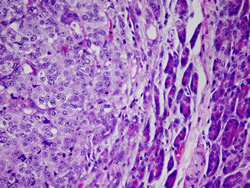Last updated: July 31, 2012
NIH researchers achieve better understanding of skin cancer
NIH researchers achieve better understanding of skin cancer
By Raymond MacDougall
Associate Communications Director for Intramural Research
Melanocytes — the skin's pigments cells — are sensitive to the sun's ultraviolet radiation, which, along with chemical and other exposures, can trigger DNA damage. The genetic material that fabricates, organizes and invigorates the skin cells can undergo abnormal changes, or mutations.
Because mutations can cause faulty genetic instructions — some that control cell division and survival — affected melanocytes may start to grow and divide out of control. Such cells may spread to surrounding layers of the skin and to other parts of the body, resulting in a life-threatening cancer known as metastatic melanoma.
"Melanoma is very highly mutated and is in some cases mutated approximately on an order of magnitude higher than other cancer types," said Yardena Samuels, Ph.D., an investigator in the Cancer Genetics Branch of the National Human Genome Research Institute's (NHGRI) Division of Intramural Research. Dr. Samuels is part of a National Institutes of Health (NIH)-led team studying the genetics of melanoma and is the senior author of an article in the Sept. 25, 2011, early online issue of Nature Genetics that found that mutations in the metabotropic glutamate receptor-3 (GRM3) gene cause some cases of melanoma.
This newest melanoma-causing mutation joins a growing list of culprits. In April 2011, Nature Genetics published the team's first systematic genomic probe of melanoma. Using whole-exome sequencing, a technique that deciphers just the portions of the genome that code for proteins, the researchers identified 15 new mutations that drive cancer development and one that had previously been detected. The researchers found that one of the mutated genes, GRIN2A, is mutated in 25 percent of melanoma cases. It is located in the signaling pathway for the nerve cell messenger glutamate — the same pathway as GRM3.
In the current study, the researchers focused on mutations in the largest human gene family, G protein-coupled receptors (GPCRs). The significance of the receptors coded by GPCR genes is underscored by the fact that they are the targets of more than half of drugs approved by the U.S. Food and Drug Administration (FDA). Additionally, genes in the GPCR family regulate signal pathways for cell growth, the hallmark cellular activity in cancer.
NHGRI researchers and a colleague from the Johns Hopkins Sidney Kimmel Comprehensive Cancer Center in Baltimore designed and analyzed the new study, while National Cancer Institute (NCI) researchers, including Steven Rosenberg, M.D., Ph.D., chief of surgery at the NCI, and colleagues from the University of Texas MD Anderson Cancer Center in Houston and the University of Colorado Denver School of Medicine collected melanoma tumor samples.
The researchers obtained DNA from 11 melanoma tumor samples and sequenced the exon region — or protein-coding portion of the DNA sequence — that spanned the 734 GPCR genes. Mutational analysis narrowed the interest of the researchers to a group of 11 genes in the GPCR family that contained two or more mutations. The team accessed an additional 80 melanoma samples and detected that one particular gene, GRM3, had a high mutation rate in the tumor samples. Furthermore, multiple tumor samples contained the precise mutation in the very same location within the gene, an occurrence characterized as a mutational 'hot spot.' This prevalent recurrence indicates that the mutation has a selective advantage, elevating its importance as a mutation that drives the development of cancer.
To explore the function of this gene, the researchers studied melanoma cells that harbor the mutations. In an experiment that heightened the function of mutated GRM3, the researchers detected increased activity of a signal pathway called the MAP kinase pathway, already known to be involved in melanoma. A kinase is a type of protein enzyme that modifies other proteins to cause some particular cell function. The pathway includes a kinase known as MEK targeted by current melanoma drugs. While some targeted treatments have been effective, tumors become drug resistant within months of treatment. The pathway also is associated with the most highly mutated gene in melanoma, called BRAF.
The researchers performed a test to detect whether the cells with the newly identified mutation in GRM3 respond to the drug that inhibits the MEK pathway. They detected that mutated cells treated with a MEK inhibitor responded positively, dying off as they should rather than persistently replicating as cancer cells.
Further analysis showed that when the cells carry both a BRAF mutation and a GRM3 mutation, the inhibitor compound selectively killed the cells that had the GRM3 mutation. Dr. Samuels suggested that in some cases, failure of melanoma cells to respond to a MEK inhibitor might be due to those cells having a BRAF mutation but no GRM3 mutation. Dr. Samuels predicts that prospective genetic analysis will enable differentiation of melanoma into subclasses.
"Melanoma has been subdivided by pathological characteristics," she said. "With the advent of in-depth genetic analyses, it may become possible to classify melanoma by its genetic alterations. Based on our two recent studies, I predict several melanoma subclasses will be identified in the near future."
For a high resolution micrograph of metastatic melanoma, please go to:
www.genome.gov/dmd/img.cfm?node=Photos/Technology/Cells%20and%20biological%20pathways&id=79201 and
www.genome.gov/dmd/img.cfm?node=Photos/Technology/Cells and biological pathways&id=79202.

